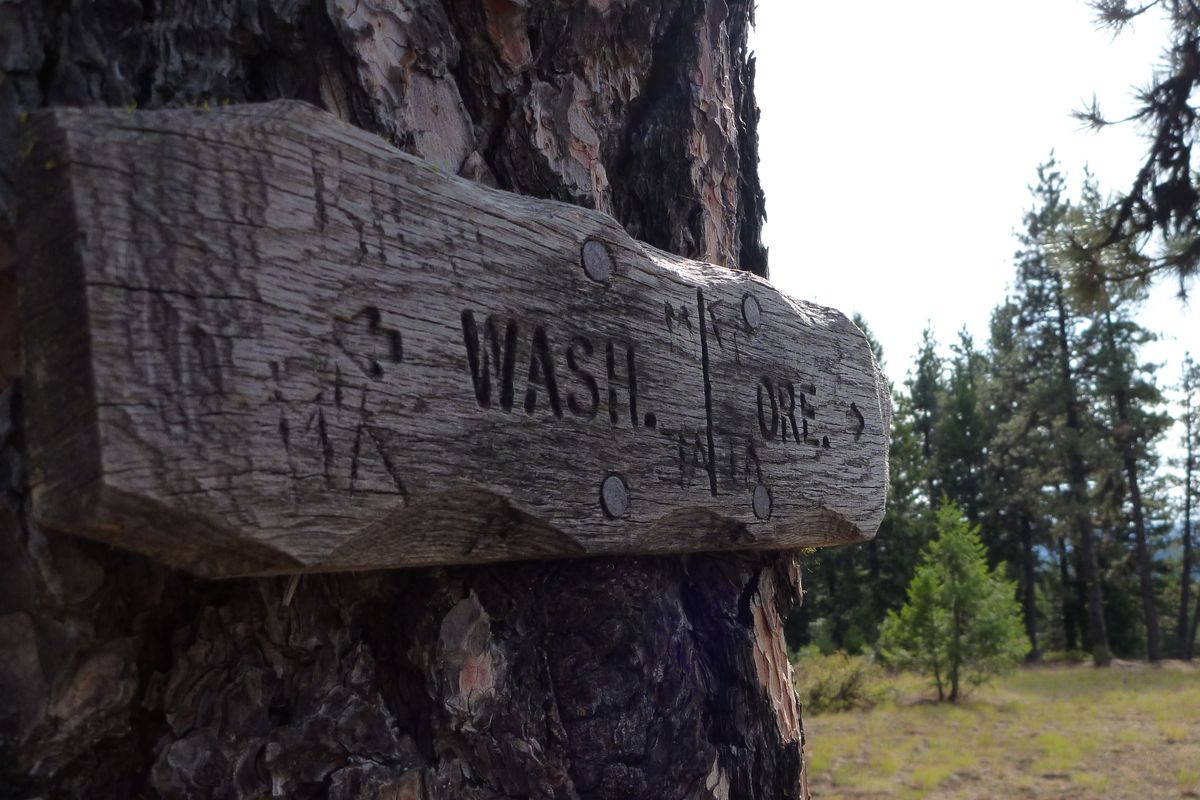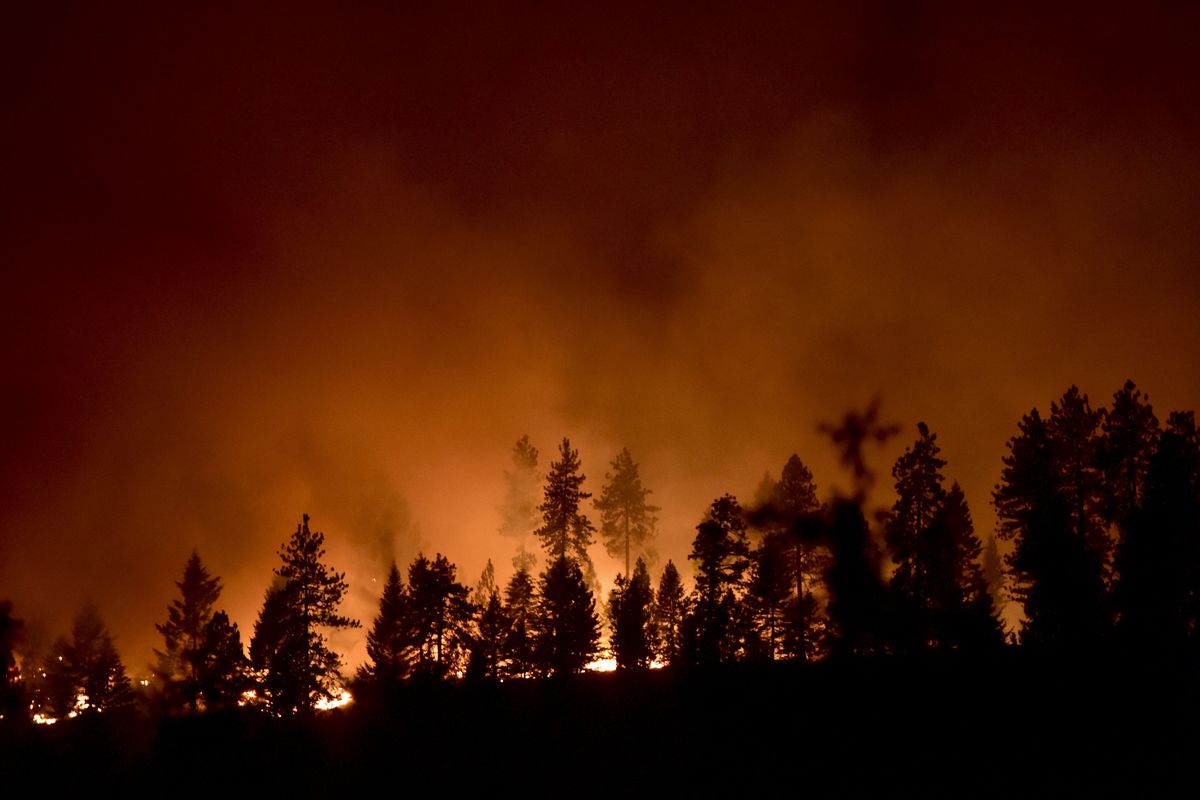Wildfire closures block access to popular hunting, hiking, boating areas
The Carpenter Road Fire, part of the Stevens Complex Fire, burns a prime deer and elk hunting region near Turk Road just southeast of Fruitland. (Tyler Tjomsland)Buy a print of this photo
Drought and wildfires in the Inland Northwest are raising havoc with fish and wildlife as well as with hunters, hikers, boaters and other recreationists who consider August a prime month for their pursuits.
The outlook is fairly bleak for September, too.
Archery deer and elk seasons plus general black bear seasons are opening around the region with huge chunks of traditional hunting areas closed to public access.
Hikers are rerouting plans as fire closures block access to prized trails in the Salmo-Priest, Wenaha-Tucannon and Pasayten wilderness areas as well as the Scotchman Peak roadless area.
Campers of all types are feeling the heat as virtually all public land managers have banned campfires, barbecue briquettes, driving off road and operating chainsaws and other power tools.
All of the commercial timberland in the region – more than a million acres including Potlatch, Stimson and Inland Empire Paper – has been closed to public access since early July as a fire prevention measure during the driest summer on record.
More recently, national forests have had to close roads and trails in vast areas to keep the public out of the way of firefighters and prevent recreationists from getting trapped by unpredictable blazes.
Most of the current fires have been caused by lightning over a tinder-dry landscape.
The 1.1-million acre Colville National Forest has closed access to six areas, including the Salmo-Priest Wilderness and trails and roads north, east and south of Sullivan Lake. Developed campgrounds at the lake remain open.
However, even boaters have to make a plan to avoid fire closures in some areas. Lake Roosevelt National Recreation Area has closed all boat ramps and day-use areas in the Kettle Falls District except for the Kettle Falls marina and boat ramp because of expanding wildfires.
Wildlife officials in Washington and Idaho say they are getting calls from hunters, landowners and wildlife enthusiasts. None of the states in the region has immediate plans to delay or curtail hunting seasons.
In Oregon, Baker County Commissioners sent a letter last Thursday to Gov. Kate Brown requesting a delay in hunting seasons to appease farmers and ranchers concerned about fire danger. The request was denied.
The commissioners soon learned that changing carefully scheduled hunting availability causes a domino effect that impacts not only hunters but also businesses and wildlife. Hunters have put in for permits and planned vacations for set seasons, making delays and adjustments ill advised.
If hunting seasons were closed, there’d be a demand to close hiking, fishing, rock hounding, boating and virtually all other outdoor recreation.
Hunters with early-season permits for specific fire-impacted units might be out of luck, but not totally ignored.
The nine bowhunters with coveted quality bull permits for Washington’s two Blue Mountains Wenaha units may not be able to reach their hunting grounds before the season closes Sept. 24.
“We can’t roll over their permits to next year,” said Kevin Robinette, Washington Department of Fish and Wildlife regional wildlife manager in Spokane. “But barring a miracle rain that would allow the area to reopen, we’ll be contacting them and restoring their hunter preference points for next year’s drawings.”
Even with that consolation, being forced back into another drawing is a bitter pill for hunters who beat the high odds for the lottery permits, perhaps after more than a decade of trying.
Some game management units, such as the areas near Omak eastward to Unit 113 in Pend Oreille County, are marked by significant fire access restrictions on public and commercial forests.
“Access closures control a lot of recreational activity, but we don’t want to close hunting in an area where there’s private landowners who might want to hunt on their own back 40,” Robinette said. “That wouldn’t work out.”
Idaho has a more liberal policy for hunters blocked out of their hunting area. In very limited cases, Idaho Fish and Game offers rain checks or refunds when season-long access to a hunting unit is blocked by fire. Persons requesting a rain check must submit their tags and describe how fires blocked their ability to hunt. If the rain check is granted, a 2016 tag would be offered for the same species and hunt area.
Hunters with Idaho controlled hunt tags can exchange them for general season tags before the controlled hunt begins, but controlled-hunt fees would not be refunded.
“Hunters should be prepared to postpone their hunts or move to different areas if their hunting spots are affected by fires,” Idaho officials said in a media release Tuesday.
Meanwhile, those planning outdoor recreation in fire-impacted areas should check ahead for access updates.
In the Priest Lake area, the only trail closure as of Wednesday was Trail 308 along the Upper Priest River. The Idaho Department of Lands had not closed trails on the east side of Priest Lake, but officials are pleading with anyone who calls or visits the Coolin office to use extreme caution outdoors.
Sandpoint area hikers have been temporarily barred from Trail 65 to Scotchman Peak, one of the most popular trail destinations in North Idaho. The Scotchman Fire started northeast of Clark Fork around Aug. 13 and is one of six in the Clark Fork Complex that have charred about 13,000 acres.
The Grizzly Bear Fire, burning 20 miles southeast of Dayton, has scorched about 60,000 acres in the Wenaha-Tucannon Wilderness. The fire is named not for the animal – grizzlies don’t inhabit the Wenaha – but rather for a wilderness ridge popular with hunters and hikers heading down toward the Wenaha River.
Fishermen are affected in many areas, such as those who might be planning to travel the Gold Pass route from St. Regis to the St. Joe River. Road 50 over Gold Pass has been closed by the Snow Peak Complex fires. Access is closed to trails south of the St. Joe River, including the Mallard-Larkins area.
And this is just a sampling of fire-affected areas.
Yet there’s still a lot of room to roam if you want to get out and dodge the smoke plumes.
“From a square-mile standpoint, there’s still a lot of the Coeur d’Alene and St. Joe areas still open to access,” said Wayne Wakkinen, Idaho Fish and Game regional wildlife manager in Coeur d’Alene.
“That’s good news for people who want to get out, but we realize it doesn’t help people who are used to hunting areas that are closed.”
A hunter who’s learned to hunt an area wants to go back to the same place. He’s made an investment.
“This year, at least for the early seasons, everybody’s going to have to be more flexible – and extra careful,” Wakkinen said.


